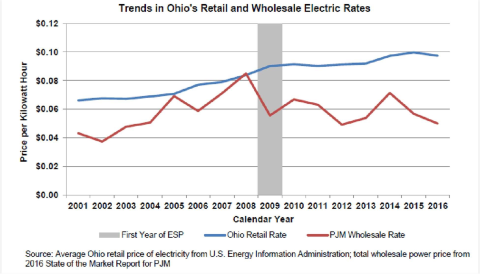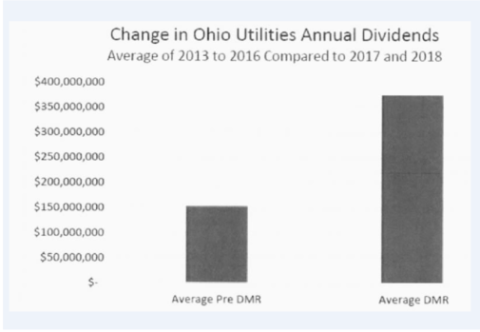Before
The Ohio Senate
Energy and Public Utilities Committee
Testimony on Substitute House Bill 6
(l_133_1512-1 version)
Presented by Michael Haugh
On Behalf of the
Office of the Ohio Consumers’ Counsel
June 27, 2019
Hello Chair Wilson, Vice Chair McColley, Ranking Member Williams and members of the Committee. Thank you for this opportunity to testify. My name is Michael Haugh. I am testifying as a consultant on behalf of the Ohio Consumers’ Counsel, after formerly serving as OCC’s assistant analytical director. OCC is the state’s representative of over four million residential utility consumers. I have previously testified for OCC in opposition to House Bill 6. OCC appreciates the consumer protections resulting from Senate changes to the Substitute Bill that was released on June 26th. But fundamentally the bill remains a bailout of aging nuclear power plants, at public expense, for bankrupt FirstEnergy Solutions and its big Wall Street creditors. And it enables a continued bailout of the 1950’s OVEC coal power plants, at public expense, for big utilities and their investors. (Lines 1271-1272). Even in its improved form, the bill will transfer about a billion dollars in above-market charges from Ohio families and businesses to FirstEnergy Solutions’ investors. That is bad. The bill similarly will allow the continued bailout of the two OVEC coal plants, including the Clifty Creek plant outside of Ohio in Madison Indiana, at a total cost of about $300 million after the current utility rate plans end.
That is also bad. Given the bill’s approach of subsidies instead of competitive markets, the Ohio Consumers’ Counsel continues to oppose House Bill 6. Attachment 1 is testimony last session from the Industrial Energy Consumers that explains the fallacies of subsidizing the OVEC coal plants. And I do appreciate the truth in ratemaking where the Substitute Bill no longer calls the OVEC plants a “national security resource,” which they are not.
I also appreciate the Senate’s removal of the language requiring electric consumers of AEP, Duke and DP&L to subsidize the former share of bankrupt FirstEnergy Solutions for the OVEC coal plants’ losses. But past experience reflects that the PUCO likely will allow utilities this additional OVEC subsidy at public expense even without a law. So for consumer protection, the bill should end OVEC subsidies no later than when the current PUCO subsidy orders expire. At the least, the bill should require stronger guardrails for consumer protection than what is in the bill now (lines 1266-1298) that the PUCO would have to resolve in considering whether to continue subsidizing OVEC plants.
All these aging power plants that the General Assembly will subsidize with public money are the outdated technologies of the old energy economy. Worse, the subsidies will roll up (not roll out) the welcome mat for investment in the new energy economy in Ohio. Investors in the competitive power plants of the future, who should be welcomed in Ohio as the future job creators and technology innovators, will not be attracted to a business climate in Ohio where their competitors get subsidized with corporate welfare at public expense. Further, the competitive markets that the bill undermines have provided low-cost power to Ohio electric customers. Low electric prices encourage business investment and job creation.
Ohio should not be picking winners and losers by providing subsidies to power plants that cannot compete in the wholesale energy markets. The subsidy approach is contrary to the competitive vision of Ohio’s 1999 electric deregulation law. A graph (from page 2 of a Legislative Service Commission Fiscal Note for H.B. 247 (132nd General Assembly)) depicts my concerns.

The LSC graph shows a decrease in PJM wholesale electric rates since 2008. That should be good for consumers. But the LSC graph shows a rise in Ohio retail electric prices since 2009. That is bad for consumers. LSC explained that “the lack of correlation between wholesale and retail prices emerges around calendar year 2009, which is the same year that Ohio’s utilities began operating under ESPs.” It was Ohio’s 2008 energy law (S.B. 221) that created electric security plans and their government intrusion into competitive markets. Here we go again with H.B. 6.
One of the improvements in the bill is to the woefully inadequate audit provision. (Lines 309 to 343) I commend the new audit provisions on lines 309-343 that provide some consumer protections. But auditors should be given an effective standard to audit against, which the bill still lacks. An effective standard would be a simple standard that power plants will not be subsidized at public expense if their revenues are meeting their operational expenses. That standard should be added to the bill. Already the Senate has heard testimony with controversy over whether the power plants are or will be profitable, with new information that the plants will be profitable without subsidies. Experience – such as with the disastrous ratemaking for consumers in 2008’s Senate Bill 221 – shows that consumers do not fare well (they fare poorly) with ambiguity for alleged consumer protections in ratemaking law.
Further, lines 125-132 state the Ohio Air Quality Development Authority “may decertify a qualifying resource” if the owner no longer requires payments. That language should be strengthened by requiring the OAQDA to decertify the resource (power plant) if the audit finds that the plant’s operational costs are being met though all revenues it receives. But improvements don’t save the bill from itself – it’s still a bailout of uneconomic power plants subsidized by captive customers. However, I would like to identify a few other improvements in this Substitute Bill. The removal of the decoupling provision protects consumers from utilities needlessly charging customers for reduced usage. The elimination of shared savings (utility profits) after 2020 in the utility energy efficiency programs will significantly reduce consumer costs. (Line 1113). This new limitation on utility profiteering (so-called shared savings) from their energy efficiency programs is protective of consumers. Ohio law should not allow FirstEnergy, AEP, DP&L, and Duke to charge consumers for any profits on their energy efficiency programs. Lines 1326-1329 prevent non-participating customers from having to pay for on-site renewable projects. Although this type of project could and should be provided by the competitive market, it is appreciated that residential customers will not be paying for these projects.
Last week was a real bad week, that should have been a good week, for two million consumers of FirstEnergy. They succeeded in a Supreme Court decision to overturn the PUCO’s misuse of the 2008 energy law. The PUCO granted a subsidy to FirstEnergy of about a half-billion dollars from consumers for a so-called “distribution modernization rider” (that FirstEnergy didn’t have to spend on distribution modernization). The connection to H.B. 6 is that it was a subsidy and the subsidy was for credit support that would relate in part to the troubled finances of the ultimately bankrupt FirstEnergy Solutions. It should have been a good week for consumers with the end of the charge, but it was a bad week with the Court’s decision that consumers would not receive a refund of nearly half a billion dollars from FirstEnergy. One way to bring more balance for consumers to this bill that favors the utility industry is to solve the problem of the lack of refunds that the Court previously stated can be solved by the General Assembly. In other words, this bill should be amended to enable refunds when any legal authority such as the Court, FERC or the PUCO later finds charges to be improper.
Further, a consultant audit released this month by the PUCO, regarding FirstEnergy’s distribution modernization rider, is revealing for House Bill 6 regarding what can happen with subsidies. According to the auditor, during the time the distribution modernization rider was being collected from customers, dividends paid by the FirstEnergy utilities to their parent “increased considerably” (averaging $375 million) compared to “pre-DMR” dividends (averaging $152 million). See PUCO Case No. 17-2474-EL-RDR, Oxford Advisors Compliance
Review, Mid-term Report at p. 12 (June 14, 2019):
http://dis.puc.state.oh.us/TiffToPDf/A1001001A19F14B63203J01876.pdf
Here is one of the PUCO auditor’s charts showing the correlation between consumers’ subsidy payments to FirstEnergy and FirstEnergy transferring wealth to its investor/owner:

We recommend that FirstEnergy, its affiliates and (future) former affiliates like FES make money based on their achievements in the market and not through government-imposed hand- outs from Ohio families and businesses. In this regard, attached is OCC’s “Subsidy Scorecard” (Attachment 2) showing what FirstEnergy and the other Ohio electric utilities have charged consumers for subsidies since the 1999 Ohio deregulation law.
And, for balance for consumers, I recommend other protections. Those include removing the FirstEnergy profit protection from the budget bill (H.B. 166) or even better, deleting the word “significantly” from the 2008 law, as in “significantly excessive earnings,” so that consumers would more broadly be protected from paying any excessive profits. The profit issue could also be solved by eliminating electric security plans or at least improving their worst piece parts such as the removing the allowance of a utility “veto” of a PUCO order that modifies its security plan; fixing the profits issue as described above; and fixing the “more favorable” than a market rate offer standard to prohibit use of qualitative factors.
The Substitute Bill is a better bill than the House version but it should be judged on its fundamental provisions to subsidize power plants in a state (Ohio) that has (or had) a vision for deregulated competitive markets. Instead of the invisible hand of the market, there continues to be the heavy hand of government in the market. That should have ended after 1999 and it should at least end now. I urge you to vote against Substitute House Bill 6.
Thank you for this opportunity to testify.
